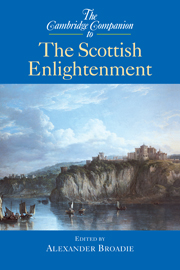Book contents
- Frontmatter
- Introduction
- 1 The contexts of the Scottish Enlightenment
- 2 Religion and rational theology
- 3 The human mind and its powers
- 4 Anthropology: the ‘original’ of human nature
- 5 Science in the Scottish Enlightenment
- 6 Scepticism and common sense
- 7 Moral sense and the foundations of morals
- 8 The political theory of the Scottish Enlightenment
- 9 Economic theory
- 10 Natural jurisprudence and the theory of justice
- 11 Legal theory
- 12 Sociality and socialisation
- 13 Historiography
- 14 Art and aesthetic theory
- 15 The impact on Europe
- 16 The impact on America: Scottish philosophy and the American founding
- 17 The nineteenth-century aftermath
- Select bibliography
- Index
14 - Art and aesthetic theory
Published online by Cambridge University Press: 28 May 2006
- Frontmatter
- Introduction
- 1 The contexts of the Scottish Enlightenment
- 2 Religion and rational theology
- 3 The human mind and its powers
- 4 Anthropology: the ‘original’ of human nature
- 5 Science in the Scottish Enlightenment
- 6 Scepticism and common sense
- 7 Moral sense and the foundations of morals
- 8 The political theory of the Scottish Enlightenment
- 9 Economic theory
- 10 Natural jurisprudence and the theory of justice
- 11 Legal theory
- 12 Sociality and socialisation
- 13 Historiography
- 14 Art and aesthetic theory
- 15 The impact on Europe
- 16 The impact on America: Scottish philosophy and the American founding
- 17 The nineteenth-century aftermath
- Select bibliography
- Index
Summary
Philosophers of the Scottish Enlightenment did not invent aesthetics, the philosophical study of beauty, the sublime, and related categories, but they did make a highly significant contribution to it. The two most important writers in the field were Francis Hutcheson and David Hume, though others, such as George Turnbull, George Campbell, Alexander Gerard, Allan Ramsay (the painter), Henry Home (Lord Kames), Adam Smith, Thomas Reid, Hugh Blair and Archibald Alison, were significant writers on the subject. Indeed, the sheer number of truly inventive works on aesthetics was a distinctive feature of the Enlightenment in Scotland. In section one I offer some critical reflections on Hutcheson's work, paying particular attention to the role that the doctrine of the association of ideas plays in his thinking. Hume's work on aesthetics owes a great deal to Hutcheson's though he reaches different conclusions. Section two explores Hume's conclusions regarding the existence and identification of the standard of taste. In the writings of the two men moral and aesthetic categories are often combined. A particularly interesting exercise in the combination of these categories is to be found in the writings of George Turnbull, regent at Marischal College, Aberdeen between 1721 and 1727, and section three contains a discussion of his contribution to this field. In the final section I consider the views of George Turnbull and his pupil George Campbell on truth in the arts. Aesthetic theory in the Scottish Enlightenment is a field filled with a rich variety of good things, and in this chapter I shall cover only a small area of this field and shall attend to only a very few of the thinkers who made a significant contribution.
- Type
- Chapter
- Information
- The Cambridge Companion to the Scottish Enlightenment , pp. 280 - 297Publisher: Cambridge University PressPrint publication year: 2003



